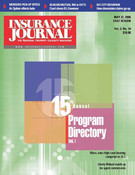Kinnect is dead! Long live Kinnect! Although Lloyd’s long troubled IT project was consigned to the flames last January (See IJ Website Jan. 24), a number of IT phoenix have risen from its ashes.
“I think 2006 is going to be an extraordinary year,” said Alex Letts, CEO of RI3K, the company that currently provides platform technology infrastructure for the reinsurance industry. “By the end of September the London Market will be full accessible technologically.”
Kinnect’s failure opens doors
Conceived in 2001, Kinnect aimed at reforming the way Lloyd’s brokers and underwriters have done business for over 300 years by replacing the bulging slip cases (and the approximately four tons of paper Lloyd’s produces every day) with an integrated electronic platform.
Although practically everybody at Lloyd’s agreed adopting IT was necessary, Kinnect never really worked for a number of reasons. Primarily no one really wanted to actually use it. Some analysts and critics charged that Lloyd’s was basically resistant to any changes. But such has not proven to be the case. An earlier article pointed out (See IJ Magazine April 3), that Lloyd’s reaction to the U.K.’s Financial Services Authority’s (FSA’s) mandate to achieve 85 percent contract certainty by December 2006 was largely seen as an “opportunity to implement change,” according to Steven Haasz, its director of change management and human resources.
That spirit applies to other areas as well. Haasz said Kinnect’s object was to “create the tools to help the market become more efficient.” It aimed to do something about its reliance on written forms by organizing a master system to which the brokers and underwriters would adhere.
This may have been a viable approach in 2001. But as time went by, and nothing happened, the companies and the brokers created their own systems. Finally acting Kinnect Chairman Michael Dawson told Lloyd’s Franchise Board “that support for a centrally built hub was not sufficient to continue the development of Kinnect.” Dawson deduced that since 2001 a series of IT developments had gathered enough momentum to replace Lloyd’s antiquated infrastructure without forcing everyone to use the same system.
“The market’s organization is bigger and more mature, said Haasz, “and the technology is better.” Not only do the standards now exist, which make the use of technology easier, but also the technology itself has improved. Companies continue to upgrade their systems, as new and more efficient technology becomes available. Today’s IT can do a great deal more than what was available in 2001. Kinnect’s time essentially passed before it ever arrived.
“Made to measure” technology
At the end of the day its main accomplishment was to prime the Lloyd’s market to accept newer and better IT solutions, not to discourage the use of IT altogether.
“Aon uses electronic trading, so does Benfield,” Haasz said. “Then you have companies like E-reinsurance and RI3K. The solutions exist and the tools are more efficient.” He admitted that closing Kinnect had been disappointing, but “overall it was a good decision, as there are now other commercial alternatives.”
In retrospect it should have been obvious that Lloyd’s, the ultimate broker market, wouldn’t have been able to impose a rigid system on the Syndicates and the brokers, each of whom have different specialties, different ways of doing business and therefore different technological needs. How do you put marine, D&O, aviation, commercial property, all the reinsurance treaties and the other Lloyd’s specialties into one system? However, when Kinnect was conceived those “commercial alternatives” didn’t exist.
Nick Furlonge, Beazley’s director of risk management and the co-founder of the firm with Andrew Beazley in 1986, recognized that Lloyd’s needs to move into the electronic world, but he also said it became increasingly evident that Kinnect wasn’t the answer.
“We were very supportive of Kinnect,” he said, “and we were sorry to see it go.” However, he doesn’t think it’s a total catastrophe. “We have put in place software, the Beazley Gateway, which allows us to communicate with the brokers on a ‘peer to peer’ basis, and we are well along on working out common standards with the broking houses.”
Beazley is a member of the “Group of 6” (the others are Catlin, Hiscox, Amlin, Wellington and Kiln) who have taken the lead in modernizing Lloyd’s processes. Their goal, which is also the goal of Lloyd’s three-year strategy to “build the optimal platform,” is to keep the London Market competitive in an increasingly crowded insurance world.
In addition to creating contract certainty and modernizing its business processes, it means cutting costs. The London market remains an expensive place to do business — too many people handling too much paper is the prime reason.
“After all these years the message on costs has finally gotten through,” said Letts. “Once they closed Kinnect the industry could ‘smell the coffee.'”
He noted that systems like Beazley’s are no longer an exception. “The G-6 has taken the lead in bringing Web-based services to the market,” Letts continued. “The initiatives are there to be delivered, particularly electronic trading.”
That message takes on added importance, as the messenger, who’s headed RI3K since its inception, hasn’t always been so optimistic. In a speech to the Insurance Institute of London in January (See IJ Website Jan.26, 2006) he warned: “We have to move to modern, streamlined processes and processing that is relevant to a world that has moved on from the Guilds and Lloyd’s coffee shop days. If you don’t get an electronic marketplace soon, London will become irrelevant. Grow the physical market, but the world has to see that it has moved on to underpin itself with the ability to move the contracts, records and processing data electronically. Technically this is easier than people would have you think.”
Light at the end of the tunnel?
Asked if his recent statements signaled the light at the end of the tunnel, Letts replied, “Oh, we’re out of tunnel; it’s a whole new part of the countryside.” He now sees RI3K as part of a larger equation and as one of the “architects” of the emerging electronic platforms being installed on desks all over the City. The company is working on a version of its reinsurance platform for primary coverage, and plans to unveil it soon.
The service providers have done their job,” Letts continued. “They’ve rolled out the products necessary to create an electronic marketplace.” He sees the entire London market eventually using systems that will enable brokers and underwriters to exchange quotes, send messages and other relevant data by electronic means either through e-mails or their own systems. Each will have the ability to pick, and choose the data they require “using their existing systems” off of the available platform.
“However,” Letts continued, “this won’t happen overnight. First the major brokers will move [many in fact already have]; then the process will continue.” It will certainly take some time for Lloyd’s to transfer the policies written from its entire $26 billion 2006 capacity from paper to electronic forms. But for Letts the breakthrough is the fact that “we now have the ability, the rest is simply managing the process.”
If he’s right, it’s a true sea change for Lloyd’s. It would further strengthen the London market to the advantage of all.
Topics Trends Agencies Excess Surplus Tech Reinsurance Market London Lloyd's
Was this article valuable?
Here are more articles you may enjoy.


 Miami Retirement Fund Class Action Alleges Globe Life Officers Concealed Fraud
Miami Retirement Fund Class Action Alleges Globe Life Officers Concealed Fraud  Insurer Chubb Readies $350M Payout Tied to Baltimore Bridge Collapse
Insurer Chubb Readies $350M Payout Tied to Baltimore Bridge Collapse  Update: Fannie Mae Guidelines Raise Concerns, Could Bar ACV Coverage for Homes
Update: Fannie Mae Guidelines Raise Concerns, Could Bar ACV Coverage for Homes  Viewpoint: The 10 Major Risks Shaping Insurance Today
Viewpoint: The 10 Major Risks Shaping Insurance Today 


